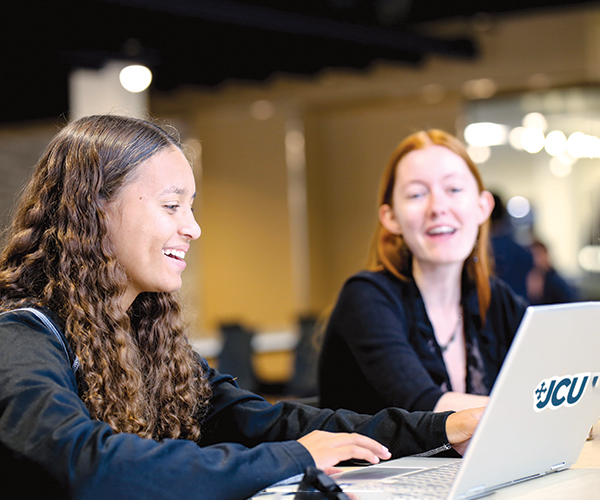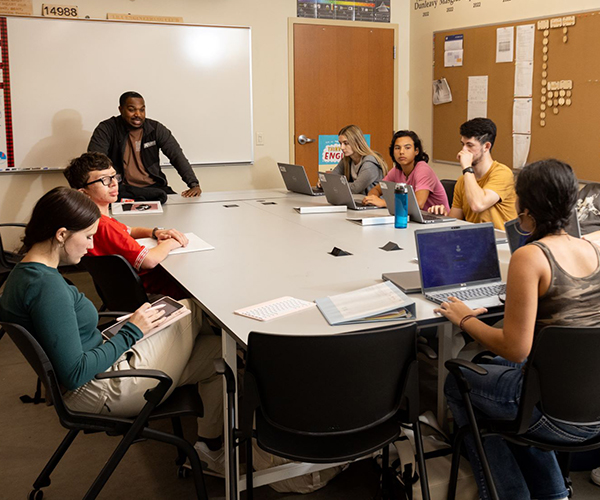College Marketing in the New Millennium
As students become increasingly tech-savvy, schools work to meet them in a new medium.
by Beth Stallings | Feb. 27, 2006 | 5:00 AM
As soon as the SATs were over, 18-year-old Andrew Rafferty remembers receiving an overwhelming amount of college-recruiting information. His mailbox and e-mail inbox were full of brochures and letters from colleges thoughout the country, promoting academic programs, encouraging him to come visit and ultimately redirecting him back to their Web sites for more detailed information.
Now a freshman at John Carroll University, Rafferty admits he's not the most organized person and the droves of mail were hardly touched until after he knew exactly what he was looking for in a college.
Otherwise, he says, trying to differentiate between brochures would have been too hard, because on paper, every school looked exactly the same. Rafferty was like many other high school seniors - overwhelmed, skeptical and looking for a good fit.
Now, It's Personal
"They're screen-agers," laughs Chris Munoz, vice provost for undergraduate enrollment at Case Western Reserve University. He says teens today screen everything from mail to phone calls to e-mail. They're harder to reach and as a result need a more catered approach. Or as Munoz suggests, colleges today need to meet students in their medium.
"This is the generation called the 'Net generation," he says. "Students are now using the Web to create communities. So, universities have taken up and used this to their advantage." These communities are formed in chat rooms, through Instant Messenger and on online social networks such as www.facebook.com, a site specifically for college students and alumni where students can form online clubs and manage personal profiles.
The Case admissions Web site has formed its own community for prospective students to join - where they can chat one-on-one with an admissions counselor, fill out a personal profile, and create a username and password. When students log on to the Case admissions Web site for the first time, a window prompts them to enter their name, e-mail address and other personal information such as home address and potential major.
From here on, the Web site view changes to fit the needs of that specific student, Munoz says. For example, the site carries a variety of banner advertisements, including one that connects students with their local alumni. Because the site already knows where the student is from, the link will encourage students to click for alums in Cleveland, Chicago, Los Angeles or wherever they are located.
"Any prospective student can personalize the site," Munoz says. And "they are invited to apply online." Case is even considering eliminating paper applications. Prospective students who apply online can check their application status any time, including to see if admissions officers have received high school transcripts or if financial aid was awarded.
For Case, a nationally recognized university that enrolls 3,500 undergraduate students, the Web-specific method is the easiest way to cater individually to students throughout the country.
Similarly, administrators at Hiram College have changed their technique to go "Web-fat and publication-thin." They realized a new approach was in order when fewer students were responding to traditional mailings.
"Students are much more likely to answer an e-mail than take a phone call or respond to a piece of mail," says Timothy Bryan, vice president for institutional advancement for Hiram College. When students express an interest in Hiram, the first thing the school asks for is their e-mail address. And while the school could purchase mass lists of e-mail addresses from the SAT board, doing so is not really cost effective, Bryan says.
Since switching to Web-based marketing, inquiries at Hiram are up 20 percent, Bryan says, which was 120 additional applications last January. "You want to reach them where they exist, and where they exist is in the virtual world," he says.
On the Cutting Edge
At Baldwin-Wallace College in Berea, 12 student-run blogs are available on the admissions Web site so prospective students can follow the lives of B-W students of various ages and with varied interests.
In November, Robin Spann, now a freshman blogger at B-W, was approached by his adviser about the new blog a faculty member was setting up. Spann says he was interested in blogging from the get-go because when he was "looking for colleges there were some questions that weren't answered, especially by the tour guides."
As a prospective student, Spann figured tour guides and administrators were trying to sell the school, so of course most answers were going to be positive.
"I thought it'd be nice to do," Spann says, especially if something at school, like a class, didn't go the way he expected. He could be honest and tell students about things that disappointed him but also things that excited him.
A recent blog posting by the 18-year-old English major described an evening at Dave and Busters, a combination bar, restaurant and video game arcade a short drive from campus.
"I was just trying to give students an idea that there were things to do, but not too far off campus," says Spann, who posts his blog twice a week. "Normally I just write about classes and teachers and experiences on campus."
The blog appeals to Spann because he remembers how much he preferred e-mail and Web sites over sifting through mailed brochures to learn more about various schools.
"After a while there's so many coming and I felt like I needed to read them all," Spann says. "But with the Internet, I could look anytime, because it would always be there."
Similar to Case, B-W allows students to personalize the site. Baldwin-Wallace, which enrolls 3,000 undergrads, views the Web site as a "personalization piece" that makes the site more "dynamic" to provide an extra personal touch, says Dan Downhower, director of undergraduate admission.
And to refer the students back to the site, B-W has become one of the first schools in the country to use broadcast text messaging to people's cell phones and mobile devices. The text messages were designed to remind prospective students about campus events and recruiting activities. The first message, sent last October, reminded prospective students about an open house and then referred them back to the school Web site.
"It's really very cool," Downhower says. He explains the texts are specified to student interests. When prospective students sign up, they tell Baldwin-Wallace their intended major, the career they would like to pursue and extracurriculars they may want to join - and the messages are catered to those needs.
For example, Downhower says they will send text messages announcing varsity athletic games to students interested in specific sports.
"We're really trying to provide as much information in small snippets and engage students with things we do," he says. "We're keeping it very specific to their major or interest."
Admissions counselors at B-W settled on the new text messaging approach when they, like Hiram, realized students were switching mediums and could be reached beyond paper mail. Text messages were chosen over mass e-mails because of the personal touch they could offer and the growing number of teens using cell phones.
"The number of teens text-messaging is kind of high," says Susan Dileno, vice president for enrollment management at B-W. "A 14-year-old doesn't go anywhere without that phone." In fact, Dileno was initially surprised how willingly students gave phone numbers to the school and how few students have opted out of the text messaging program.
The MTV Generation
Hiram has focused heavily on using peer-to-peer communications because it feels the format is more credible, especially for students looking for that perfect fit in a college. Hiram, which has a student body of 1,200 undergraduate students, has changed its recruitment DVD accordingly.
"They want to see people. We've been promoting a dramatic change for us," Bryan says. "Instead of talking heads and narrators, we have a new DVD that is essentially 99 percent students talking about their experiences."
This gives them a higher level of credibility because what the students are saying was not scripted for them. They are real students talking about real experiences - real-live reality TV.
"We wanted it to be authentic," Bryan says, explaining these were students chosen from what they said about Hiram at interviews, not from a script.
"One-on-one interaction is very important here," Bryan says. He explains Hiram follows up the DVD with students from the video calling prospective students at home, giving campus tours and volunteering in the overnight visit program. Seeing the same faces, so prospective students know they are real people, gives them necessary consistency, Bryan says.
"The best way to do that is to allow them to talk to students," he says.
Cuyahoga Community College is running an active campaign that focuses its TV ads on cable channels with specific audiences, such as MTV and the Cartoon Network, that appeal to its target audience - people ranging in age from 18 to 35.
The campaign is based less on medium and more on the message sent to students about how Tri-C will prepare them for the working world - a primary concern for many Tri-C students.
"Our latest campaign is all about connections and Tri-C connecting students with employers.
We've really enhanced on that," says Michael Devlin, vice president marketing and communications. Called the "Connect Campaign," it is focused on showing students how the college can link them to employers or new technology to advance skills for their current and future careers.
The Tried and True
At Tri-C, an active call center and advertising campaign keeps the school's personal approach strong. As a community college, it's difficult to be strictly Web-based and successfully recruit students.
"We don't want to be another annoying e-mail message someone is going to delete," Devlin says.
"We're not going to ambush them like that."
So, Tri-C doesn't rely on e-mail, adding that addresses change too often and getting the e-mail address in the first place can be difficult.
"That personal touch, for us, is very important," says Devlin. "That's what we want to strive for."
While paper mail isn't the most popular marketing tool anymore, Bryan says there will always be a need for print because students still want something tangible, a "flagship piece" that they can show people when asked where they are going to school.
Baldwin-Wallace decided to try a different marketing scheme after research showed only 10 percent to 25 percent of e-mail messages sent were opened.
"We're going backward in terms of going through paper mail," Dileno says. "We're going to an older way." Now, it is a "duplication of efforts" as she says, combining electronic and traditional mail.
"Students are very eager to use electronic information when they're instigating it. It's a struggle because they're not always eager to receive it," according to Dileno.
As a high school senior, Rafferty remembers receiving the majority of marketing materials through the mail, which is exactly how he liked it.
"I wasn't a big fan of e-mails," says Rafferty, double majoring in communications and political science at John Carroll. "It's hard to sort them out. I like the mail and they certainly were visible enough with mail."
He says e-mails only came after he had expressed interest in the school, but it was the "mail-mail" that got him interested and on to the next step - going on a college visit. The thing that put Rafferty over the top and made him choose John Carroll was speaking with current students and alums who didn't have a bad thing to say about the school, he says.
"If you look at the mail, all the colleges and cities look the same. It's all about going out and talking with people who go there," Rafferty says.
Trending
-
1
-
2
-
3
-
4
-
5










